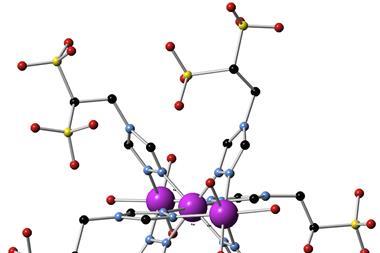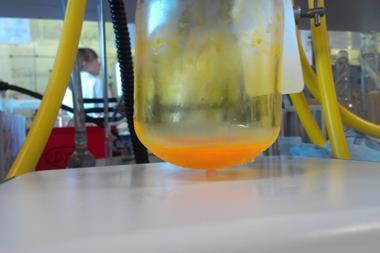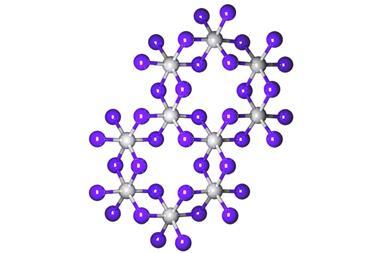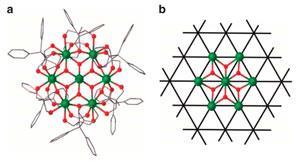Sandwich compound keeps its magnetic memory at –213°C, bringing ultra-dense data storage a step closer
A sandwich-like dysprosium compound is the hottest single molecule magnet ever made. It stays magnetised up to –213°C – still a trifle chilly, but far warmer than the previous record holder. Individual molecules that can retain binary information as magnetic states could dramatically increase information density. Today’s hard drives rely on magnetic nanoparticles, which are huge in comparison with single molecules so molecular magnets could revolutionise data storage.
However, single molecule magnets only work at extremely low temperature, usually around –269°C, the boiling point of helium. Above this temperature, molecular vibrations quickly muddle the magnetic moment and the compound loses its magnetic memory.
![Synthesis of [Dy(Cpttt)2][B(C6F5)4]](https://d2cbg94ubxgsnp.cloudfront.net/Pictures/480xany/7/1/6/132716_nature23447_proof1-fig-1a.jpg)
Since 2011, a terbium compound that stays magnetised up to –259°C has held the record for single molecule magnets. But this record has now been smashed by dysprosocenium – a dysprosium atom sandwiched between two aromatic rings – that stays magnetic up to a positively sizzling 60K. ‘It’s a big breakthrough,’ says Gopalan Rajaraman, a molecular magnetism researcher from the Indian Institute of Technology Bombay. ‘If you had asked me five years ago if that would be possible, I would have said: maybe not,’ Rajaraman reveals.
As to why dysprosocenium can get hotter than other molecular magnets without losing its magnetism, ‘we think it’s a result of the [cyclopentadiene] rings,’ says Nicholas Chilton from the University of Manchester, UK. ‘This is the first example [of a dysprosium compound] that has only small aromatic rings binding to the metal.’ Dysprosium’s five unpaired electrons form the basis of its magnetic memory, but the ligands increase and stabilise the magnetic moment’s uneven distribution, therefore upping its working temperature.
To make the seemingly simple compound, the team had to overcome dysprosium’s aversion to low coordination numbers. ‘Lanthanides love to be eight, nine or 10-coordinate and cyclopentadiene rings just take up about three coordination sites each,’ explains David Mills, also at Manchester. ‘Geoffrey Wilkinson predicted this back in the 1950s and people have been trying to make it ever since.’ Chilton and Mills used a seven-coordinate precursor and removed one of the ligands with a strong reducing agent – the same strategy Richard Layfield’s team, also from the University of Manchester, reported in a separate publication.2
‘It is not just a record molecule but a huge leap for the field, and should inspire much enthusiasm and hope for the future of magnetic materials,’ comments Selvan Demir, who works on single molecule magnets at the University of Göttingen in Germany. ‘There are many, many complexes of dysprosium and cyclopentadiene derivatives, spanning a variety of coordination geometries. Yet it is this specific structure […] that engenders truly remarkable magnetic properties,’ she adds.
Mills, Chilton and their team will now try to push molecular magnets to 77K, at which point they could be cooled with liquid nitrogen rather than colder, but more expensive liquefied gases. ‘We have lots of things to try, for example changing the substituents on the cyclopentadiene ring,’ suggests Mills.
The ultimate goal, however, will be to make single molecule magnets work at room temperature, says Rajaraman. ‘I think that this work brings the dream to life.’
References
1 C A P Goodwin et al, Nature, 2017, DOI: 10.1038/nature23447
2 F-S Guo et al, Angew. Chem., Int. Ed., 2017, DOI: 10.1002/anie.201705426







![Molecular structure of the cation of [Tb(Cpttt)2][B(C6F5)4]·CH2Cl2](https://d2cbg94ubxgsnp.cloudfront.net/Pictures/380x253/6/3/6/138636_c8cc05261a-f2_index.jpg)









No comments yet